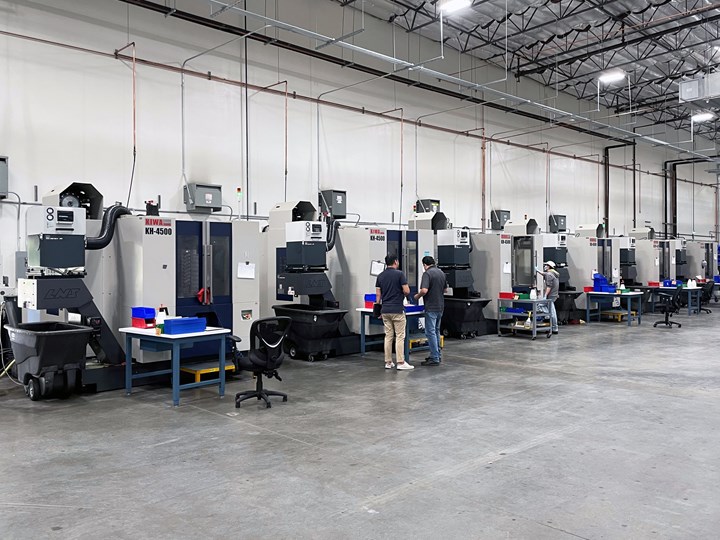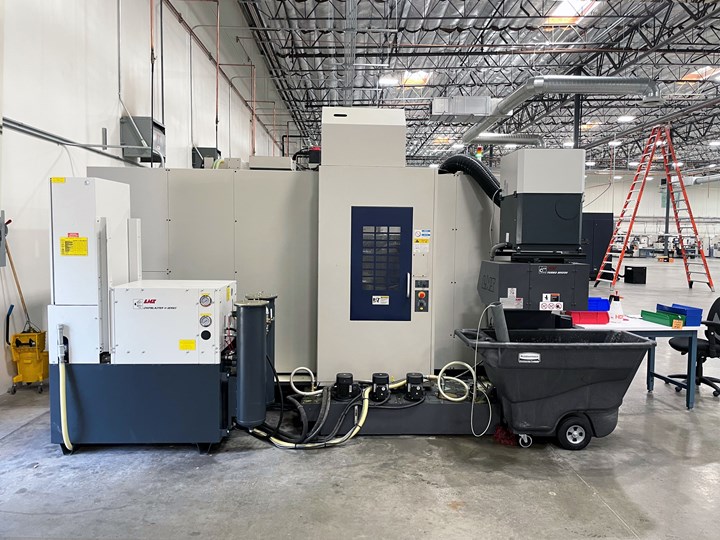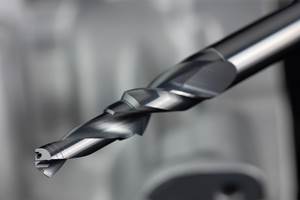High-Pressure Coolant System Reduces Cycle Time More Than 6 Hours
A suite of systems from LNS has enabled Velco Tool & Die to reduce cycle times and increase its throughput.
Share





Manufacturing high-volume, high precision components for the medical device industry is the mainstay of Velco Tool & Die in Lake Forest, California. Owner Joe Velez oversees manufacturing of proprietary parts used for surgical tools and other equipment, many of which are machined from 17-4 PH (SAE 630) stainless steel alloy bar stock or plates. “We use 17-4 for its strength, hardness and corrosion resistance. Of course, the material’s hardness means the drilling and milling operations on some parts are time-consuming. We’re always looking for ways to reduce production time and increase output.”

Velco Tool & Die equipped these CNC machining centers with LNS Chipblaster high-pressure systems, filtering chip conveyors, and oil mist collectors to reduce each cell’s cycle time 6 hours, 32 minutes. Photo Credit: LNS
One such process that included multiple drilling holes required 8 hours, 40 minutes to produce 240 parts. Wishing to reduce this cycle time, Velez contacted LNS to discuss how applying a high-pressure coolant system might impact machining these parts. The result was a decision to move forward with the LNS Chipblaster system.
Although high-pressure coolant typically improves CNC machine performance by better controlling temperature in the cutting zone and more efficiently removing chips, in drilling operations the benefits dramatically increase by replacing conventional twist drills with through-hole drills. Because conventional twist drills remove material from the hole as they work, only a small amount of coolant reaches into the cutting area, reducing the coolant’s ability to control material temperature. However, forcing the coolant into a through-hole cutting tool at a precise pressure enables more efficient cooling of the workpiece and increases drill lubrication while flushing chips out of the hole to avoid recutting and premature tool wear. These factors work together to reduce drilling time and, by so doing, allow the machine tool to move on to milling operations more quickly.

Velco calculates it saves over $1,000 per year on coolant costs, alone, using a Venturi syphon to take coolant out of the chip hopper and into the coolant tank. Photo Credit: LNS
Theoretically, fitting Velco’s CNC machines with LNS Chipblasters would provide the cycle time savings Velez desired. To translate theory into reality, LNS outfitted one CNC machining cell with a Chipblaster V-40 programmable, variable high-pressure system that automatically applies optimal pressure and flow for each operation.
Once installed, Velco conducted a time study comparing the pre-high-pressure process with the same set of operations using the Chipblaster high-pressure system and through-hole carbide drills. Previously, the process took 8 hours and 40 minutes to complete 240 parts. The addition of the high-pressure system to the same process reduced total cycle time to 2 hours and 8 minutes, a savings of 6 hours, 32 minutes.
According to Velez, “The results more than met our expectations. Not only has the high-pressure system greatly reduced drilling time, it also improves milling time, all of which means greater spindle usage. Making more chips means more jobs. We also save on coolant costs, because the system includes a Venturi syphon that takes coolant out of the chip hopper and into the coolant tank. Our figures indicate we save about $1,000 per year on coolant costs alone. At first, I was concerned about replacing the conventional drills with the more expensive through-hole drills, but the improved cycle times and extended tool life more than justifies the cost difference. We have no complaints, although the machine operators joke that they now have to change pallets 3 – 4 times more often per shift.”
 To manage increased chip production and extend coolant life, Velco depends on the LNS MH Series filtering chip conveyor to prevent backups and to filter chip particles out of the coolant. Photo Credit: LNS
To manage increased chip production and extend coolant life, Velco depends on the LNS MH Series filtering chip conveyor to prevent backups and to filter chip particles out of the coolant. Photo Credit: LNS“I can see that the cost of investing in high-pressure systems and more expensive tooling may put some shop owners off, but the cost-benefit analyses we’ve done prove that making these kinds of process improvements more than justify the initial cost. The LNS people had the expertise to work closely with us, study our manufacturing process and recommend the best solution.” Velez says.
Based on the results of their time study, Velco equipped 5 more CNC machines with the LNS Chipblaster systems. Each machining cell is also equipped with an LNS MH 500 filtering chip conveyor. “The chip conveyors are an essential part of the improved system. They keep up with the increased chip production, so we don’t have backups or slowdowns, and they filter chip particles out of the coolant, so we save both time and coolant costs.”
In previous collaboration with Velco Tool & Die, LNS had led the implementation of its Tryton and Express bar feeders for the various dimeter bar stocks they machine. The shop also recently upgraded its HVAC system to fully air condition the facility and turned to LNS to solve another problem. “We were concerned about the amount of oil mist the CNC machines were producing.” Of course, Velco’s priority is the health and safety of their employees, so they wanted to eliminate the mist from the air and oily residue from workplace surfaces. To do so they installed 6 LNS Fox WS 2 Series Oil/Coolant Mist Collectors that provide an average efficiency above 99%.
Related Content
Finding the Right Tools for a Turning Shop
Xcelicut is a startup shop that has grown thanks to the right machines, cutting tools, grants and other resources.
Read MoreCeratizit Product Update Enhances Cutting Tool Solutions
The company has updated its MaxiMill 273-08 face mill, WPC – Change Drill, as well as the HyPower Rough and HyPower Access 4.5-degree hydraulic chucks.
Read MoreEmuge-Franken's New Drill Geometry Optimizes Chipbreaking
PunchDrill features patent-pending geometry with a chipbreaker that produces short chips to control machining forces.
Read MoreThe Future of High Feed Milling in Modern Manufacturing
Achieve higher metal removal rates and enhanced predictability with ISCAR’s advanced high-feed milling tools — optimized for today’s competitive global market.
Read MoreRead Next
Setting Up the Building Blocks for a Digital Factory
Woodward Inc. spent over a year developing an API to connect machines to its digital factory. Caron Engineering’s MiConnect has cut most of this process while also granting the shop greater access to machine information.
Read More5 Rules of Thumb for Buying CNC Machine Tools
Use these tips to carefully plan your machine tool purchases and to avoid regretting your decision later.
Read MoreBuilding Out a Foundation for Student Machinists
Autodesk and Haas have teamed up to produce an introductory course for students that covers the basics of CAD, CAM and CNC while providing them with a portfolio part.
Read More





























